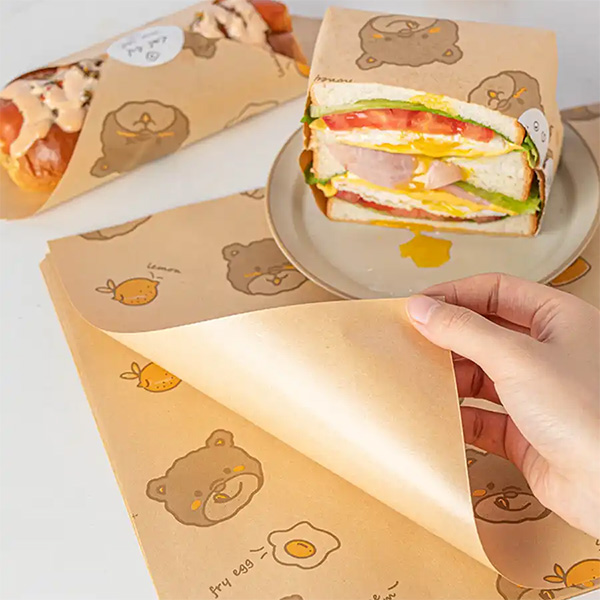Food Greaseproof Paper, also called food-grade oil-resistant paper, is a specialized, food-safe material designed to resist the absorption and penetration of oils, fats, and liquids. It’s widely used in food preparation, storage, and serving—while complying with strict safety standards (such as FDA, EU 10/2011, or China’s GB 4806 series) to ensure no harmful substances leach into food, making it safe for direct contact with edible items.

Its utility comes from three key traits:
Grease Resistance: This is its most important feature. It blocks oils (e.g., from fried foods like french fries, pastries, or burgers) from seeping through, preventing grease stains on hands, containers, or surfaces, and keeping food clean.
Food Safety: It’s made from high-purity raw materials (usually wood pulp or plant-based fibers) and processed without toxic additives like heavy metals or harmful chemicals, meeting global food contact safety requirements.
Partial Moisture Barrier: Unlike fully waterproof materials (such as plastic), it has mild moisture resistance. It can absorb minor condensation (e.g., from cold sandwiches) without getting soggy, or protect dry foods (like cookies) from humidity—though it can’t block large amounts of liquid.
Its oil-resistant ability is created through two common processes, chosen based on intended use:
Calendering (Uncoated Type): Raw wood pulp is pressed under high pressure and temperature using “calender rolls.” This compacts the paper fibers into a dense, tight structure, leaving almost no gaps for oil to penetrate. This type is thinner and more breathable, suitable for foods with low-to-moderate grease (e.g., baked goods, sandwiches).
Coating (Coated Type): For stronger grease resistance (needed for fried foods like fried chicken or fatty meats), the paper is coated with a thin, food-safe layer. Common coatings include plant-based waxes (beeswax, carnauba wax, which add natural barriers and mild heat resistance), polysaccharides (starch, cellulose derivatives, creating non-toxic, biodegradable oil shields), or food-grade polymers (polyethylene/PE, offering better grease and moisture resistance for takeout containers or microwave use).
It’s a staple in home kitchens, bakeries, cafes, and food retail, with diverse applications:
Cooking & Baking: Lines baking trays (for cookies, pastries) or air fryer baskets to prevent sticking and reduce cleanup; wraps foods like fish or veggies for steaming/grilling to lock in flavor.
Serving & Takeout: Wraps fried foods (fries, onion rings), burgers, or sandwiches to absorb excess grease and keep hands clean; lines paper boxes (for sushi, pastries) to avoid oil stains on packaging.
Storage: Wraps cheese, cured meats, or fresh bread—breathable uncoated types help maintain freshness without absorbing oils.
Baking Aids: Acts as a partial alternative to Parchment Paper (for low-heat tasks) or separates layers of dough, cookies, or candy to prevent sticking.
Many people mix up the two, but they serve distinct purposes:
Food Greaseproof Paper’s primary function is blocking oil/fat penetration and absorbing minor moisture, while parchment paper’s main role is resisting high heat (up to 230–260°C/450–500°F) and preventing sticking during cooking. In terms of heat resistance, Greaseproof Paper only handles low to moderate heat (not for high-heat baking or roasting), whereas parchment paper is safe for ovens, air fryers, and grills. Their coatings also differ: greaseproof paper uses wax, polysaccharides, or PE (for grease resistance), while parchment paper uses a silicone coating (for heat resistance and non-stick properties). For use cases, greaseproof paper works best for fried foods, sandwiches, takeout, and low-heat tasks; parchment paper is ideal for oven baking (cookies, cakes), roasting veggies, and other high-heat cooking. Finally, greaseproof paper has mild water resistance (blocks oil but not heavy moisture), while parchment paper resists steam and moisture more effectively.
Modern food greaseproof paper often focuses on sustainability:
Biodegradable Options: Uncoated or wax-coated (beeswax/carnauba) varieties are fully biodegradable and compostable, unlike plastic-lined alternatives.
Recyclability: Some uncoated types can be recycled (check local recycling guidelines), but coated versions (especially those with PE) may need separate disposal due to the coating.
In short, food greaseproof paper is a practical, safe, and versatile solution for managing oils in food handling—essential for both home and professional food settings.
Previous: Greaseproof Paper Custom